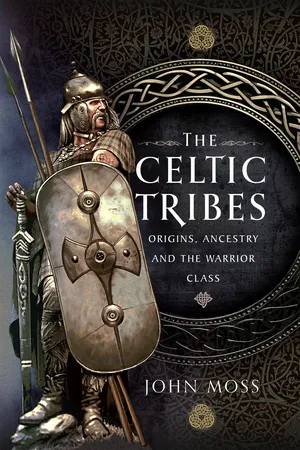
- English
- ePUB (mobile friendly)
- Available on iOS & Android
About this book
Explores the rise, migrations, and eventual decline of the Celtic tribes, detailing their wars, culture, and resistance against Roman expansion. The people we know as the Celts were an Iron Age culture that originated in central Europe, probably around modern-day Hungary, Southern Germany and the Czech Republic, somethree thousand years ago. They were groups of distinct tribal peoples who shared a commonlanguage and culture that thrived until they were confronted by an aggressive andexpansionist Roman Empire set on conquest. This book traces their many migrations westward over the following centuries, and theiradvances into the Atlantic coastal regions, especially into countries like France, Spain, Portugal, Belgium, Britain and Ireland, largely replacing the Neolithic people that formerlyoccupied these territories. These migrations were rarely peaceful and as a result the Celtswere widely regarded as warlike and inherently aggressive. The book describes the many inter-tribal and territorial confrontations that occurred duringthe Roman period. It explains the fighting methods, tactics and style of Celtic warfare as wellas the warrior leaders like Boudicca, Brennus, Ambiorix and Vercingetorix, and others whoemerged to resist Roman incursions. Despite fierce resistance, in the end, little of that greatculture survived intact. Many of these tribes were savagely and purposely exterminated as amatter of policy, others were Romanised to become reluctant citizens of the Roman Republic, and only those whose territories lay in the northern and western extremities of the Empire –in the British islands, Ireland and Brittany in North-West France, avoided total subjugation. Several hundred of these ancient Celtic and other related tribes are included here.Although each had its own distinct identity, they shared a common culture with a widespreadand unifying system of religious belief largely held together by Druids.The tribes described in the book include Gauls, Germans, Galatians, Lusitanians, Britons, Picts, Cambrians and Caledonians, among many others.
Frequently asked questions
- Essential is ideal for learners and professionals who enjoy exploring a wide range of subjects. Access the Essential Library with 800,000+ trusted titles and best-sellers across business, personal growth, and the humanities. Includes unlimited reading time and Standard Read Aloud voice.
- Complete: Perfect for advanced learners and researchers needing full, unrestricted access. Unlock 1.4M+ books across hundreds of subjects, including academic and specialized titles. The Complete Plan also includes advanced features like Premium Read Aloud and Research Assistant.
Please note we cannot support devices running on iOS 13 and Android 7 or earlier. Learn more about using the app.
Information
Table of contents
- Cover
- Dedication
- Title
- Copyright
- Contents
- Introduction
- Chapter One: Celtic Origins, Ancestry & Migrations
- Chapter Two: Contemporary Attitudes to the Celtic Warrior
- Chapter Three: Celtic Tribal Leaders & Warrior Heroes
- Chapter Four: The Druids & Celtic Religion
- Chapter Five: The Tribes of Gaul
- Chapter Six: The Tribes of the Iberian Peninsula
- Chapter Seven: The Tribes of Galatia
- Chapter Eight: The Tribes of Brittany
- Chapter Nine: The British Tribes
- Chapter Ten: The Scottish & Pictish Tribes
- Chapter Eleven: The Welsh Tribes
- Chapter Twelve: The Irish Tribes
- Chapter Thirteen: The Germanic Tribes
- Bibliography
- Useful Online Resources
- Plates